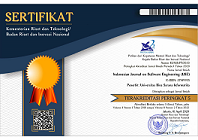Analisis Penerimaan Pengguna Pogram ICT EQEP Dengan Pendekatan Tam Di Kulon Progo
Abstract
Abstrak – Technology Acceptance Model (TAM) dan Theory of Planned Behavior (TPB) merupakan teori penerimaan teknologi yang digunakan dalam penelitian ini. Terdapat enam konstruk yang digunakan dan merupakan gabungan dari konstruk-konstruk asli yang terdapat dalam TAM dan TPB. Keenam konstruk tersebut adalah kemudahan pengguna persepsian (perceived ease of use/PEOU), kegunaan persepsian (perceived usefulness/PU), sikap terhadap penggunaan teknologi (attitude towards using technology/ATU), norma subyektif (subjectivenorm/SN), kontrol perilaku persepsian (perceived behavior control/PBC), dan minat perilaku menggunakan teknologi (behavioral intention to use/BIUS). Model gabungan ini selanjutnya digunakan untuk meneliti Program ICT EQEP yang merupakan teknologi e-learning yang digunakan di SMP penerima Program ICT EQEP. Penelitian ini selanjutnya akan menjelaskan tentang hubungan antar faktor-faktor yang mempengaruhi penerimaan dan penggunaan Program ICT EQEP di SMP penerima Program ICT EQEP.
Jenis penelitian yang digunakan dalam penelitian ini adalah penelitian eksplanatori dengan teknik analisis data menggunakan pendekatan SEM. Data diperoleh dari responden yang merupakan guru SMP atau user penerima Program ICT EQEPdi Kulon Progo dengan menyebarkan kuesioner tertutup. Terdapat 126 sampel penelitian yang dianalisis menggunakan metode SEM dengan software AMOS.
Berdasarkan hasil analisis data diperoleh hasil sebagai berikut: (1) Konstruk PEOU mempengaruhi konstruk PU; (2) Konstruk PU mempengaruhi konstruk ATU; (3) Konstruk PEOU tidak memiliki pengaruh terhadap konstruk ATU; (4) Konstruk PU tidak memiliki pengaruh terhadap konstruk BIUS; (5) Konstruk ATU mempengaruhi konstruk BIUS; (6) Konstruk SN memiliki pengaruh terhadap konstruk BIUS; dan (7) Konstruk PBC mempengaruhi konstruk BIUS. Selain itu koefisien variabel laten PU terhadap ATU memiliki nilai paling besar diantara nilai koefisien variabel laten pada model hubungan antar konstruk lainnya. Kemudahan penggunaan persepsian (PEOU) di Kulon Progo masih tergolong cukup dan cenderung rendah dengan perentase 70,63%, Sikap terhadap penggunaan teknologi (ATU) sebagian besar guru sebagai user program ICT EQEP di Kulon Progo cenderung cukup tinggi sebesar 75,40%, Tingkat Kepercayaan (PU) sebagian besar guru sebagai user program ICT EQEP di Kulon Progo bahwa penggunaan teknologi akan meningkatkan kinerja pekerjaanya cenderung cukup tinggi sebesar 69,84%. Persepsi dan konstruk-konstruk internal dan eksternal dari perilaku (PBC) sebagian besar guru sebagai user program ICT EQEP di Kulon Progo cenderung tinggi sebesar 89,69%. Persepsi atau pandangan (SN) sebagian besar guru sebagai user program ICT EQEP di Kulon Progo terhadap kepercayaan-kepercayaan orang lain sebagai pertimbangan dalam melakukan sesuatu cenderung rendah sebesar 49,21%
Kata kunci: Technology Acceptance Model (TAM), Theory of Planned Behavior (TPB), Program ICT EQEP, dan AMOS
Abstract Technology Acceptance Model (TAM) and the Theory of Planned Behavior (TPB) is a theoretical acceptance of the technology used in this research. There are six constructs used and is a combination of original constructs contained in TAM and TPB. Sixth construct is the ease of user perceived (perceived ease of use / PEOU), usability perceived (perceived usefulness / PU), attitudes towards the use of technology (attitude towards using technology / ATU), subjective norms (subjective norm / SN), control the behavior of perceived (perceived behavior control / PBC), and interest in using the technology of behavior (behavioral intention to use / BIUS). This integrated model is then used to examine the ICT program EQEP which is the e-learning technology used in junior receiver EQEP ICT program. This research will further explain the relationship between factors that affect the acceptance and use of the ICT program in junior receiver EQEP EQEP ICT program.
This type of research used in this research is explanatory research with data analysis techniques using SEM approach. Data obtained from respondents who are school teachers or the recipient user EQEP ICT program in Kulon Progo by spreading the enclosed questionnaire. There are 126 sample were analyzed using SEM with AMOS software.
Based on the analysis of data obtained as follows: (1) Construct PEOU affect construct PU; (2) Construct PU affect construct ATU; (3) Construct PEOU have no effect on the ATU construct; (4) Construct PU has no influence on BIUS construct; (5) Construct ATU affect BIUS construct; (6) Construct SN has an influence on BIUS construct; and (7) Construct PBC affects BIUS constructs. In addition to the PU latent variable coefficient ATU has the greatest value among the coefficient of latent variables in the model of the relationship between the other constructs. Perceived ease of use (PEOU) in Kulon Progo is still relatively quite and rather low with 70.63% perentase, attitude towards the use of technology (ATU) most teachers as ICT program user EQEP in Kulon Progo tend to be quite high at 75.40%, Tier belief (PU) most teachers as ICT program user EQEP in Kulon Progo that the use of technology will improve his job performance tends to be quite high at 69.84%. Perception and constructs internal and external behavior (PBC) most teachers as ICT program user EQEP in Kulon Progo tends to be high at 89.69%. Perception or view (SN) most teachers as ICT program user EQEP in Kulon Progo against the beliefs of others as the consideration of doing things tend to lower by 49.21%
Keywords: Technology Acceptance Model (TAM), Theory of Planned Behavior (TPB), ICT program EQEP, and AMOS
Full Text:
PDFReferences
Arifin, Zainal. 2009. Evaluasi Pembelajaran. Bandung: PT Remaja Rosdakarya Offset
Arikunto, Suharsimi., 2013, Prosedur Penelitian: Suatu Pendekatan Praktik,PT. Rineka Cipta, Jakarta.
Ghozali, Imam., 2005, Aplikasi Analisis Multivariate dengan Program SPSS, Badan Penerbit Universitas Diponegoro, Semarang.
_______, 2006, Aplikasi Structural Equation Modeling, Metode Alternatif dengan Partial Least Square (PLS), Edisi Pertama, Badan Penerbit Universitas Diponegoro, Semarang.
_______, 2011, Structural Equation Modeling Metode Alternatif Dengan Partial Least Square (PLS) Edisi 3, Badan Penerbit Universitas Diponegoro. Semarang.
Hasibuan, A. Zainal., 2007, Metodologi Penelitian Pada Bidang Ilmu Komputer Dan Teknologi Informasi, Fakultas Ilmu Komputer Universitas Indonesia
Jogiyanto, Hartono, 2007. Model Kesuksesan Sistem Teknologi Informasi. Yogyakarta: Andi.
Sugiyono, 2005, Metodologi Penelitian Bisnis, Cetakan Kelima, Bandung: Alfabeta.
DOI: https://doi.org/10.31294/ijse.v2i2.1131
ISSN : 2714-9935


Published by LPPM Universitas Bina Sarana Informatika
Jl. Kramat Raya No.98, Kwitang, Kec. Senen, Kota Jakarta Pusat, DKI Jakarta 10450
This work is licensed under a Creative Commons Attribution-ShareAlike 4.0 International License









